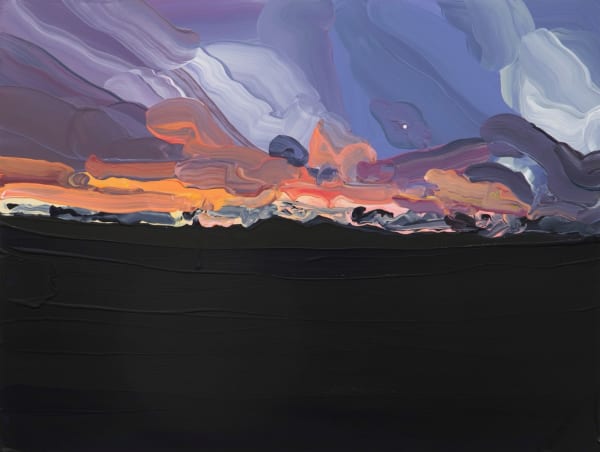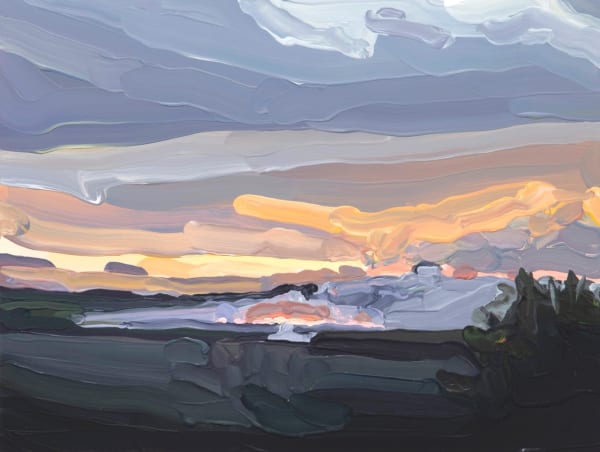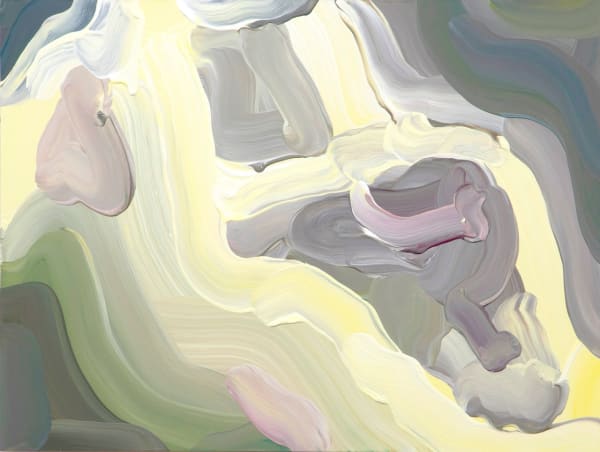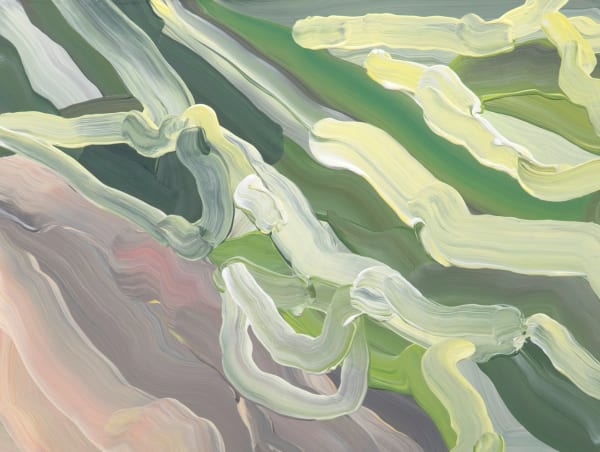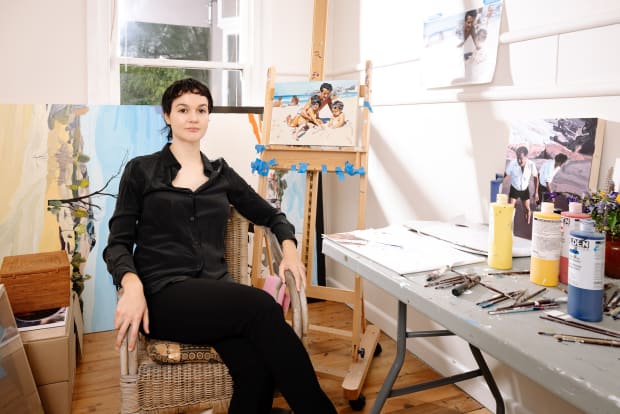-

-

-
 Thea Anamara PerkinsDylan Mooney, 2024acrylic on board30 x 40 cm
Thea Anamara PerkinsDylan Mooney, 2024acrylic on board30 x 40 cm -
Dualities.
By Thea Anamara PerkinsPast and present unfold simultaneously. Existing in a continuous dialogue, history shapes and informs contemporary conditions. This chronological interplay is central to understanding contemporary australian history, landscape and culture. Indigenous histories from time immemorial and settler colonial legacies are interlaced, influencing how we perceive, understand and recognise our relationship to Country and concepts of national identity today. The tension between the inherited and the ongoing defines much of our national story – a complex, violent and layered relationship with the land.
Yuwibara Country lies where salt and freshwater meet — a region of vast significance both environmentally and culturally. Spanning approximately 2,800 square kilometres in central queensland, Yuwibara lands stretch from St. Helens in the north to Cape Palmerston in the south, and inland as far as the Connors Range. This land was, and still is, a major meeting place for the Yuwibara people and neighbouring clan groups, a space where connections and traditions have been passed down through generations. However, the introduction of colonial forces in the 19th century overwrote these traditions, as European settlers arrived to exploit its resources. In 1860, an expedition led by John Mackay entered the region, seeking pastoral opportunities, eventually establishing settlements and colonial infrastructure on Yuwibara lands, known today as Mackay. The introduction of sugarcane farming and coal mining in the years following this cemented the colonial occupation of the area, transforming the landscape both physically and culturally.
The tension between the rich, unbroken history of the Yuwibara people and the colonial structures that overlay this land is a catalyst for Arrernte and Kalkadoon artist, Thea Anamara Perkins’ exhibition, Dualities. Perkins explored these themes as a first-time visitor to Yuwibara lands during her ten-day residency with Artspace Mackay in 2024, reflecting upon the omnipresent, often conflicting, histories that shape the contemporary experience of place across australia.
Through a series of intimate paintings and photographic works, Perkins presents an exploration of the opposing and omnipresent histories that underpin contemporary Mackay. Contrasting with the vast scale of the Foundation Gallery space, her series of six expressionistic paintings encapsulate both the light and dark of the landscape. Her gestural technique imbues the works with energy – somewhere between a memory and apparition, the works capture an impression of a place. The prevalence of gesture over a detailed replication of the landscape reflects a connection beyond the visible environment, a spiritual and ontological belonging of Aboriginal and Torres Strait Islander peoples to these lands.
The three paintings of the Mackay Gothic series explore this darkness within the landscape and the palpable feelings of menace, mystery and fear that looms on Country from past and continuing violence and extractive colonial practices. Working within genre of the australian gothic that emphasises the vastness of the continent, the perceived hostility of its natural environment and the fear of the racial Other, Perkins appropriates features of the genre to overturn colonial representations and tropes of Country. Instead, Perkins' disquietly humming depictions of Mackay at late dusk captures a sense of anxiety of the unresolved and unacknowledged histories that permeate these sites, underpinned by the violence of the European invasion and the extractive practices of colonial industries. As described by literary scholars David Punter and Glennis Byron, the Gothic genre flourishes in times of social upheaval, acting as a vehicle for uncovering fears and anxieties, for confronting that which is overlooked or denied in mainstream narratives. Perkins' contemporary take on this genre, particularly in the wake of the 2023 Referendum on the Voice to Parliament and ongoing issues like rising Blak deaths in custody, calls attention to the continued oppression of First Nations communities. These works speak to the present struggle for recognition, justice, and the acknowledgement of unhealed wounds from australia’s colonial past.
In contrast, the works Mackay Shimmer, Mackay Shimmer 1 and portrait Dylan Mooney capture the lightness, joy and resilience of the Yuwibara culture, Country and its people. These works, with their fluid and organic brushstrokes, glisten with light, evoking a sense of spiritual energy and connection. Inspired by an Arrernte song that speaks of the power of shimmering — “I am a woman and I am shimmering” — Perkins interprets this shimmering as a symbol of spiritual, ancestral power and ongoing connection to Country. These works emphasise the vitality and joy of Yuwibara culture and its enduring presence in the face of colonial violence. For Perkins, the reference to and interplay of light in these works serves not only as a visual motif but as a metaphysical force, reflecting Aboriginal Dreaming, that like light is omnipresent, asserting inherent and ongoing connections of First Nations people to Country.
The inclusion of film photographs in the exhibition are a first for Perkins, often forming part of her painting process; they are displayed here in conversation with acrylic, and further embellish the memory of place. The candid, almost postcard-like quality of these photographs — reminiscent of Destiny Deacon’s Postcards from Mummy (2003) — captures moments frozen in time. These images form part of a new visual archive that challenges colonial representations of Country as a possession or asset, offering instead a dynamic representation of the intrinsic energy of place. As seen through Perkins’ vision, these photographs assert that the land continues to evolve, resist, and remember, even in the wake of colonial dispossession.
By reframing the representation of culture and Country through the Dualities exhibition, Perkins invites a revived perspective of place that tackles aspects of the colonial legacy and sees beyond the peripheral colonialist perceptions of culture and Country. Perkins’ exploration of Yuwibara Country, both its darkness and its light, offers a poignant and powerful meditation on the deep, enduring connection that Indigenous peoples have to the land—an enduring connection that persists, despite centuries of violence and disruption. Through her work, Perkins not only reclaims the narrative of the land but also invites us to acknowledge the complexity of the national narrative, one that is defined by both history and ongoing struggle, but also by hope, healing, and the power of cultural continuity.
-
 Portrait by Jacquie Manning, courtesy of the Art Gallery of NSW
Portrait by Jacquie Manning, courtesy of the Art Gallery of NSW



